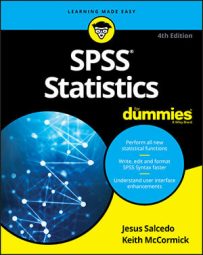| Menu | Submenu | Useful For |
| Code Book | Reports | Provides a quick look at all your variables at once. The level of measurement automatically controls which summary statistics are displayed. |
| Frequencies | Descriptives | Tells you how many of each category value you have. Most useful for categorical variables because you can run all of them at once. |
| Descriptives | Descriptives | Gets basic scale variable information, such as the mean and standard deviation. |
| Explore | Descriptives | Based on a famous book, Exploratory Data Analysis, looks at all kinds of variables as well as pairs of variables. |
| Crosstabs | Descriptives | Tests to see if categorical variables are independent of each other or related to each other. |
| Means | Compare Means | Calculates subgroup means and related statistics for dependent variables within categories of one or more independent variables. |
| One-Sample T-Test | Compare Means | Tests whether the mean of a single variable differs from a specified value (for example, a group using a new learning method compared to the school average). |
| Independent Samples T-Test | Compare Means | Tests whether the means for two groups differ on a continuous dependent variable (for example, females versus males on income). |
| Paired Samples T-Test | Compare Means | Tests whether a significant difference exists in the mean under two conditions (for example, before versus after, or standing versus sitting). |
| One-Way ANOVA | Compare Means | Tests whether the means for two or more groups differ on a continuous dependent variable (for example, drug1 versus drug2 versus drug3 on depression). |
| Bivariate Correlation | Correlate | Determines the similarity in the way two continuous variables change in value from one case (row) to another through the data. |
| Linear Regression | Regression | Predicts a continuous dependent variable from one or more continuous independent variables |
| One Sample | Nonparametric Tests | Compares the distribution of a categorical dependent variable to population norms. |
| Independent Samples | Nonparametric Tests | Tests whether the means or medians for two or more different groups differ on a dependent variable. |
| Related Samples | Nonparametric Tests | Tests whether the means or medians of the same group differ under two conditions or time points. |
| Univariate | General Linear Model | An extension of one-way ANOVA in which there is more than one independent variable. |
| Multivariate | General Linear Model | An extension of one-way ANOVA in which there is more than one dependent variable. |
| Repeated Measures | General Linear Model | An extension of the paired-samples t-test in which the same group is assessed under two or more conditions or time points. |
| Binary Logistic | Regression | Used in situations similar to linear regression but the dependent variable is dichotomous. |
| Multinomial Logistic | Regression | An extension of binary logistic regression in which the dependent variable is not restricted to two categories. |
| Discriminant | Classify | Builds a predictive model for group membership based on the linear combinations of predictors that best separate the groups. |

